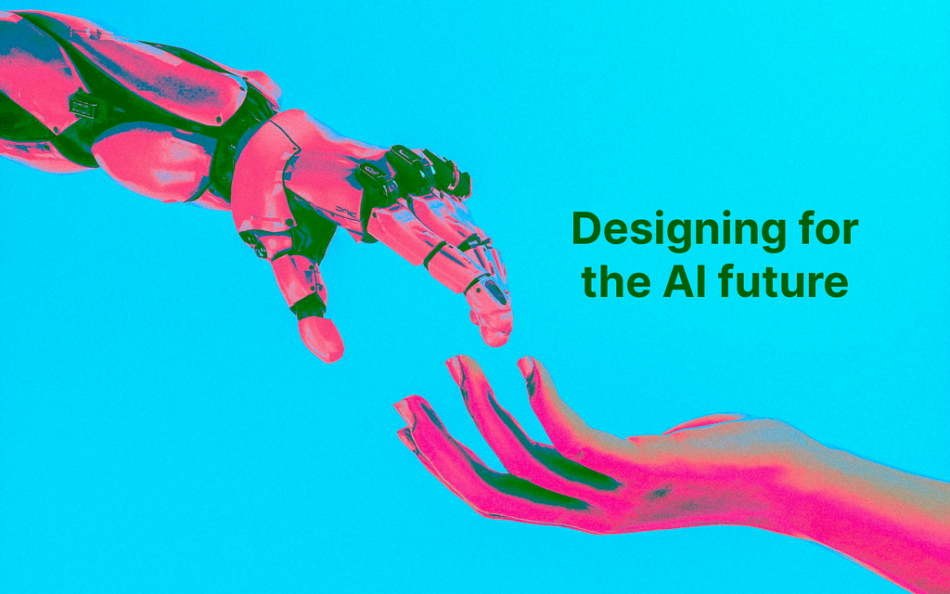4 guidelines to design with AI in mind
Photo by Cash Macanaya on Unsplash
I’ve been working on AI projects for a little while now, but I haven’t taken the time to truly reflect on how AI is reshaping my design practice. After some reflection, it has become clear that my practice is changing, and I need to continue learning and evolving. And while I’m doing that, why not share what I learn along the way? So, here are 4 areas to consider as we design for the future.
1. The Designer’s Superpower:
Being human-focused, asking why and empathising with customers is more important than ever.
The core of effective design, particularly in the age of AI, remains deeply rooted in human understanding and our ability to:
Empathise with customers: Uncover their true needs and pain points.Differentiate the experience: Identify unique value propositions for the business and opportunities to delight and enrich customer experiencesAssess overall impact: Determine the broader consequences of design decisions.Understand user journeys: Map the highs and lows of user experiences within their ecosystems.
So, where do you start? I think it’s the same place as always: a great problem statement. This ensures we focus on human challenges rather than technological solutions. One of my favourite ways to frame a problem statement is with the template below, which I have adapted from the Lean Ux Handbook :
Our intention with [Our product/service]is to help [Specific user persona or segment]
achieve [Their goals or desired outcomes]However, we’ve identified that [Observed behaviour, data insights, or user feedback]This results in [User impact, business impact, or operational inefficiencies]How might we address this gap and empower our customers to achieve [Desired outcomes],
tracked through [success metrics]?
2. Resisting the “Tech First” Mindset
Whenever a new technology emerges, there’s a tendency to prioritise its application more than grounding design in a human need.
During the blockchain era, I always heard “Can we put it on the blockchain?” Now, with AI, I hear; “How can we integrate AI into this product?”
While AI can be applied to virtually anything, framing challenges solely around technology leads to solutions that lack purpose. True impact comes from identifying genuine human needs and exploring how AI can effectively address them. This means going back to point 1 and focusing on being human-centred and addressing real business and customer needs.
Once you have defined a real need, here are some other interesting resources I have found useful. Google has created an overview of when and when not to use AI:
IBM has centred their AI design framework around “defining the intent.” This is essentially the “what” around using AI, and it can be used as a guiding principle to ensure alignment. They suggest selecting 1–2 “intents” and combining them with your problem statement to guide brainstorming.
3. Defining AI Values
Embedding AI values ensures that the products and technology you create are aligned with the core values of the business.
These values should reflect:
Ethical Considerations: Prioritising fairness, transparency, and accountability.Human Impact: Ensuring AI enhances, rather than diminishes, the human experience.Business Alignment: Aligning AI initiatives with broader business values, privacy and security guidelines.
These values should be considered throughout the product lifecycle, from research and scoping to review and iteration. Here is an example of a value alignment framework for an AI system used in a hospital setting:
If you want to delve into this more, I recommend reading this article by Harvard Business Review, which contains lots of great tips.
4. Diving Deeper Into Ethics and Risks
Evaluating risks is essential for any project, but it’s considered best practice to assess the potential broader business and societal impacts of AI design.
This involves taking the following steps:
Reflect: Take a moment to review the product’s ethical considerations.Capture: Note potential negative implications and risks.Iterate to Mitigate: Based on your findings, refine your product thinking and mitigate risks.
As a guide, you can use this IBM framework for evaluating primary, secondary, and tertiary effects, which is designed to help teams anticipate potential unintended consequences. Additionally, the Centre for Digital Content Technology. has published a good ethics canvas.
Drawing from ethics frameworks by organizations like UNESCO, NSW government and this research paper in Harvard Data, here are some of my guiding questions:
Another resource worth exploring is IDEO’s AI ethics cards, which provide great activities to prompt ethical discussions during the design process.
If you are to take one thing from this article…
Don’t skip the fundamentals of design thinking. Focus on solving real problems in a thoughtful, human-centred way.
I hope my lessons give you fresh ideas, tools, and frameworks for designing ethically and consciously using AI.
Designing for the AI future was originally published in UX Collective on Medium, where people are continuing the conversation by highlighting and responding to this story.






